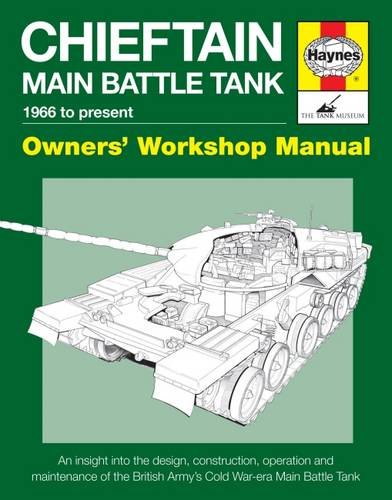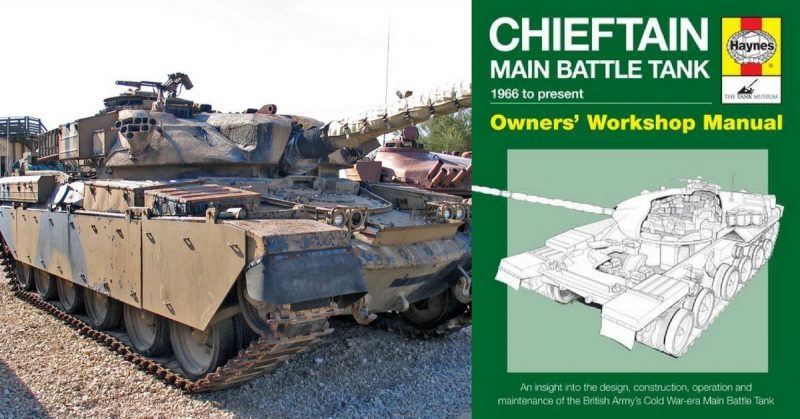I am not noted for my mechanical skills or for dexterity alighting from armored vehicles so it may come as a surprise to recall the time I did some work helping to strip a Chieftain before it went off to an uncertain fate long since forgotten.
It was a rubbish summer day with steady drizzle pouring down when I sat on the floor of the driver’s position removing anything I could unscrew or unbolt to be placed in a pile of ice cream containers supplied for the purpose. I remember the sharp edges of the mounts for the already removed driver’s seat and the pool of water seeping through the backside of my overalls. That, ladies and gentlemen, is the sum of my practical experience with Chieftain tanks.
But there is more. A number of the beasts are in private hands, and I have snapped several at a succession of military events. Ask me for a favorite, and it would have to be Shrek, an ARRV variant operated by my pal, Mark. To call it an imposing monster would not be far off the mark (no apology for the pun) and watching him sling the thing around in mud, and dust is something special.
The last time I saw one of his posts on social media he was getting big bits of the engine out, and thereby hangs a tale, because of the Chieftain; big and impressive as it is, has never been cherished for its reliability.
After some time we find ourselves back in the realm of Haynes manuals. I’ll get the spiel out of the way. This company is celebrated for their practical manuals for motor vehicles, but the Internet and modern cars themselves combined to change the landscape, leaving the publisher no option but to look for new angles. They came up with a much-liked series of owners’ workshop manuals for the sort of vehicles most of us will neither own nor sometimes even see.
This volume differs from many I have seen before because it seems to be much more personal and honest about the subject matter. The author is a tank man, a veteran of using the Chieftain in service. He pulls no punches and illustrates what a pig the tank could be with its notorious unreliability. The first tanks came out a lot heavier than intended and the selected engine and mechanicals were not up to the job. Just read the forward to get a grip on the issue.
The Chieftain had a tough act to follow the Centurion, probably Britain’s greatest tank. There were all the issues with politics and procurement that have blighted much of the big hardware in UK service in the past few decades. There is no doubt that the concept was brilliant, but the final result was found wanting. But the Chieftain was a serious bit of kit and when it was on song it was pretty amazing. The 120mm gun was a serious advance on rival weapons, and the tank’s armor was effective.
Britain sold the Chieftain to Iran, Kuwait and the Oman. The Iraqis captured many from both the Iranians and the Kuwaitis and a fair number found their way to Jordan. But the inexorable rise of the Leopard meant the Chieftain never found favor in countries where the Centurion had been readily accepted.
Some of the development had been shared with the Israelis, but the British government elected to bar Israel from buying the tank. This decision led to the Israelis going their own way with the Merkava. The relative failure of the Chieftain helped hasten the arrival of Challenger, a tank with issues of it’s own. The in-service Challenger 2 seems like a million miles away from its unreliable ancestor recalled here by Dick Taylor.
Because this book is so much more personal than others in the range, I found it to be easier to read and more real. The book is a Haynes manual to look at, but it might easily have been produced under any banner and in a range of formats. I love some of the company’s classic aircraft books because they have a similar feel, but, for me, this volume is the standout book in this series so far. Many of the pictures have the author’s personal touch while the serious stuff about mechanicals and guns etcetera is just what we expect from a Haynes book.
If you haven’t seen or heard a Chieftain at full chat then perhaps these big tanks will not mean as much to you as they do me. I have stood in fields and arenas and watched them rumbling by and the impression is one of sleek power and brutality. Whether all the tanks got home again without breaking down is a moot point.
This is a fantastic book for tank lovers. It will tell you a lot about one of the most recognizable beasts of the Cold War era, which despite all its problems in service and beyond; remains a firm favorite with enthusiasts. The author writes with authority and style, and the use of archive photography and diagrams is well up to standard. All in all, I don’t think you can go wrong with this one.
Unlike the real thing it is reliable, and at least it will fit on your bookshelf. Somewhere in my loft is a Roco-Minitanks example and I am minded to dig it out for old time’s sake. Great stuff.
Reviewed by Mark Barnes for War History Online.

CHIEFTAIN MAIN BATTLE TANKS
1966 to present
Owners’ Workshop Manual
Haynes Publishing
ISBN: 978 1 78521 059 4
